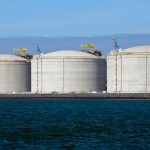Natural gas fell on Wednesday following hefty gains on Tuesday as a widespread cooling over the US took effect but upside movement was capped as weather across the majority of the country remained seasonal, while investors eyed tomorrows inventory report.
Natural gas for delivery in April traded 1.12% lower at $2.823 per million British thermal units at 9:30 GMT, shifting in a daily range of $2.854-$2.816. The contract jumped 5.1% on Tuesday to $2.855, snapping three days of losses.
According to NatGasWeather.com, natural gas demand in the US will be low-to-moderate, compared to normal, through March 24th, with a neutral weather trend for the following seven days.
Temperatures across most of the US will fall by several degrees today as a cold blast sweeps across the Northeast, while widespread showers track out of the Southwest and Mexico into Texas and the east-central US. Overnight lows over the Northeast have dropped into the teens and 20s, but the truly cold air will fail to push further south. A new stronger cold blast will impact the Midwest and Northeast on Friday and last through early next week, inducing strong heating demand for its duration, but will likely fail to push deeper past the Great Lakes, leaving the rest of the US with seasonal and slightly warmer readings.
As the cold blast fizzles, temperatures across the North will rebound back well above freezing, but weather systems tracking through with periods of rain and snow will keep readings below normal. Meanwhile, the West will remain mainly dry and warm through the end of the month and the central and eastern US will be near normal.
“We continue to view weather sentiment as neutral due to bouts of cooler temperatures pushing into the high nat gas demand states of the Midwest and Northeast through the rest of March,” NatGasWeather.com said in an e-mailed report.
Temperatures
According to AccuWeather.com, the high in New York on March 20th will be 38 degrees Fahrenheit, 13 below normal, before establishing in the mid 40s and low 50s for the rest of the month. Chicago will enjoy mostly seasonal weather throughout March, apart from a brief cooling period on March 23-25th, with readings set to range between 38 and 48 degrees on March 20th, compared to the average 32-48.
Down South, the mercury in Houston will peak at 77-78 degrees on March 20-21st, 4-5 above usual, before easing to the low-mid 70s for the remainder of the month. On the West Coast, Los Angeles will see readings peak at 75 degrees tomorrow, 5 above the average, before establishing in the lower 80s after March 24th.
Inventories
US natural gas stockpiles fell by 198 billion cubic feet in the seven days through March 6th, the EIA reported last Thursday, a withdrawal in the upper range of expectations and above the five-year average drop of 116 bcf. Total gas held in US storage hubs amounted to 1.512 trillion cubic feet, expanding a deficit to the five-year average of 1.737 trillion to 13.0%, or 225 bcf, from 7.7% a week earlier. Inventories stood at 1.029 trillion a year ago, 46.9% below current levels.
This was the last in a series of above-average withdrawals as the widespread thaw across the US curbed significantly national heating demand. Moreover, this Thursday’s supply report for the seven days ended March 13th trended lower as last week’s cold blast across the North played out less impressive. However, highs into the 80s and 90s over California last week also spurred some early cooling demand. The agency is expected to report a storage withdrawal of 30-40 billion cubic feet, compared to the five-year average decline of 45 bcf, while stockpiles slid by 69 bcf a year ago.
The report after, due on March 26th, is expected to register an inventory build, instead of a near-average decline, as the reach of Tuesday’s cold blast is limited to the Northeast and the rest of the US enjoys mostly seasonal weather. The five-year average withdrawal for the week ended March 20th is 19 billion cubic feet, while the year-ago storage drop was 56 bcf.
The following report, due on April 2nd, may reflect a near-average inventory decline, depending on how Friday’s cold blast plays out and for how long it persists.
Pivot points
According to Binary Tribune’s daily analysis, April natural gas futures’ central pivot point stands at $2.818. In case the contract penetrates the first resistance level at $2.895 per million British thermal units, it will encounter next resistance at $2.936.
If breached, upside movement may attempt to advance to $3.013 per mBtu. If the energy source drops below its S1 level at $2.777 per mBtu, it will next see support at $2.700. If the second key support zone is breached, the power-station fuel’s downward movement may extend to $2.659 per mBtu.
In weekly terms, the central pivot point is at $2.751. The three key resistance levels are as follows: R1 – $2.840, R2 – $2.953, R3 – $3.042. The three key support levels are: S1 – $2.638, S2 – $2.549, S3 – $2.436.





